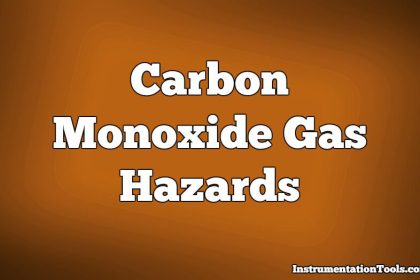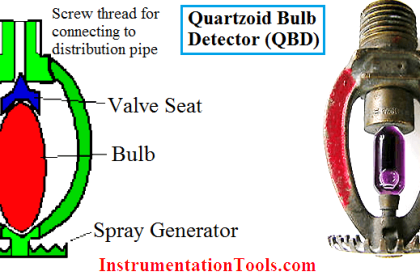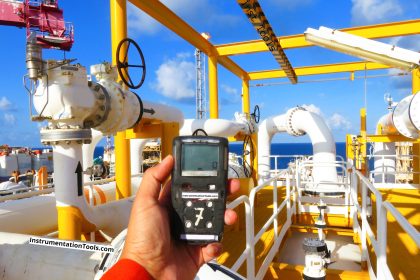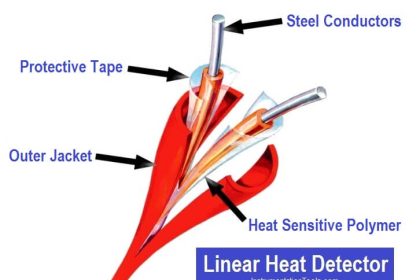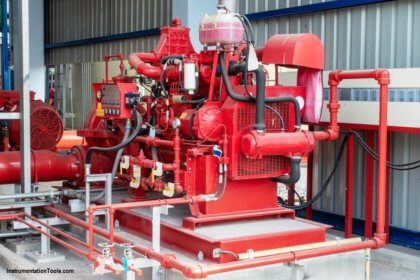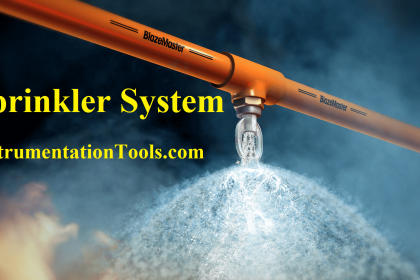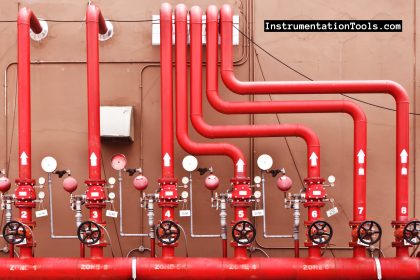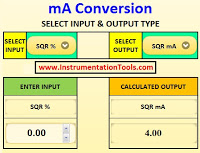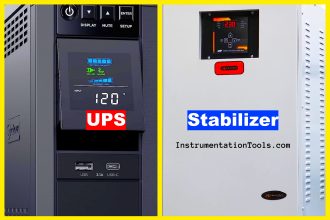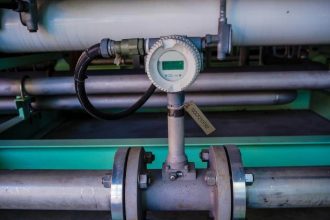Here are the list of commonly used Gas Detection System Abbreviations in fire and alarm system like IDLH, UEL, LEL, IS, PPM, TLV, STEL, Explosion proof.
Gas Detection System Abbreviations
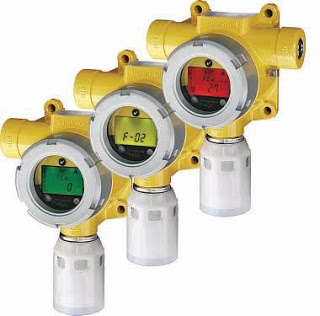
ACGIH
American Conference of Governmental Industrial Hygienists.
Alarm Set Point
The selected gas concentration level at which an alarm is activated.
Ambient air
Surrounding air to which the sensing element is normally exposed in its installed position.
Asphyxiant
A substance that impairs normal breathing by displacing oxygen.
Atmosphere
The total gases, vapors, mists and fumes present in a specific location.
Auto ignition Temperature
Also “spontaneous ignition temperature” (SIT) – The minimum temperature at which a combustible substance (gas, vapor, liquid or solid) will ignite and sustain combustion under its own heat energy.
Bump Check (Functional Test)
Procedure used to verify the response of an instrument which does not include actual adjustment. (also known as “Span Check”)
Calibration
Procedure by which the performance of a detector is verified to maximize the accuracy of its readings. A calibration is performed by:
- comparing the instrument with a known standard, and
- adjusting the instrument reading to match the standard.
Calibration Gas
(also “Span Gas”) – A known concentration of gas that is used to set instrument accuracy.
Ceiling
The maximum gas concentration to which a worker may be exposed.
Combustible Gas
A gas that is capable of igniting and burning. Any material that will burn at any temperature is considered to be “combustible”, so this term covers all such materials, regardless of how easily they ignite. The term “flammable” specifically refers to those combustible gases that ignite easily and burn rapidly.
Combustion
The rapid oxidation of a substance involving heat and light.
Confined Space
An area that is large enough for an employee to bodily enter and perform work, has limited or restricted areas of entry or exit, and is not designed for continuous human occupancy.
Controller
The part of a gas detector that provides centralized processing of the gas signal. The controller receives and responds to the electrical signal from the sensor to output an indication, alarm or other function.
Cross Sensitivity
The predictable response of a detector to compounds other than the target gas.
Dew Point
The temperature at which a gas (air) is saturated with a condensable component.
Diffusion
Process by which particles spread from regions of higher concentration to regions of lesser concentration as a result of random molecular movement.
Also used to describe the process by which the atmosphere being monitored is transported to the gas-sensing element by natural random molecular movement.
Electro-chemical Sensor
A sensor that uses an electro-chemical reaction to provide an electrical output proportional to the measured gas concentration.
Explosion
Rapid uncontrolled combustion process which generates a high temperature, a large volume of gas, and a pressure or shock wave.
Explosion proof (XP)
Method of protection in which an explosion in a hazardous location is prevented by containing any combustion within the device, and thereby, preventing it from spreading into the atmosphere surrounding the enclosure.
Explosive (or “Flammable”) Limits
Though a flammable liquid can support combustion at its flash point temperature, to sustain it requires the vapor concentration to be between two specific levels, or “flammable limits”, the lower flammable limit and the upper flammable limit. (see below) Any gas or vapor concentration that falls between these two limits is in the flammable range.
- Lower Explosive (or “Flammable”) Limit (LEL) – the minimum concentration of a vapor (usually expressed as the percentage of material in air) required to sustain a fire.
- Upper Explosive (or “Flammable”) Limit (UEL)– the maximum concentration of a vapor (usually expressed as the percentage of material in air) beyond which a fire cannot be sustained, as the amount of oxygen would be insufficient to continue the fire.
Explosive (or “Flammable”) Range
The range that encompasses any gas or vapor concentration between the substance’s lower explosive limit and upper explosive limit, and is therefore capable of sustaining combustion.
Flammable Gas
This term applies to a special group of combustible gases that ignite easily and burn rapidly.
Flash Point
The minimum temperature at which a liquid gives off enough vapor to form an ignitable mixture with air (reaching 100% LEL).
Gas
A state of matter characterized by very low density and viscosity (relative to liquids and solids), comparatively great expansion and contraction with changes in pressure and temperature, ability to diffuse readily into other gases, and ability to occupy with almost complete uniformity the whole of any container. (Often used interchangeably with “vapor”.)
Gas Detection Instrument
A device composed of electrical, optical, mechanical or chemical components that senses and responds to the presence of gas mixtures.
General Purpose (GP) Enclosure
An enclosure intended for indoor use in non- hazardous rated areas, primarily to prevent accidental contact of personnel with the enclosed equipment in areas where unusual service conditions do not exist.
Hazardous Atmosphere
(As defined by OSHA 29 CFR 1910.146) An atmosphere in which workers are exposed to the risk of death, injury, incapacitation or illness.
Humidity
The amount of water vapor present in the atmosphere.
IDLH
(Immediately Dangerous to Life and Health)**
The maximum concentration level of a substance (gas) from which a worker could escape within 30 minutes without developing immediate, severe or irreversible health effects, or other escape-impairing symptoms. IDLH levels are measured in ppm (parts per million).
**As defined by NIOSH (National Institute for Occupational Safety and Health).
* Any material that will burn at any temperature is considered to be “combustible”, so this term covers all such materials, regardless of how easily they ignite. The term “flammable” specifically refers to those combustible gases that ignite easily and burn rapidly.
Interferent
Any gas other than the target gas that will cause a response from a gas sensor.
Intrinsic Safety (IS)
A method of protection in which an explosion is prevented through an electrical design using energy storage devices in which the possibility of ignition is eliminated.
LEL
(Lower Explosive Limit). Check Here
Monitor
An instrument used to continuously measure a condition that must be kept within specific limits.
NIOSH
National Institute for Occupational Safety and Health.
OSHA
United States Department of Labor Occupational Safety and Health Administration.
Oxygen Deficient Atmosphere
An atmosphere containing less than 19.5% oxygen by volume. (Possesses a risk of insufficient oxygen for breathing.)
Oxygen Enriched Atmosphere
An atmosphere containing more than 20.8% oxygen by volume. (Possesses an increased risk of explosion.)
PEL (Permissible Exposure Limit)
An airborne concentration of contaminant that most workers can be exposed to repeatedly in a normal 8- hour day, in a 40-hour week, without adverse health effects. PEL levels are measured in ppm (parts per million) and are established by OSHA.
Permanent (or Fixed) Gas Monitor
A gas monitor that is permanently installed in a location.
PPM (Parts Per Million)
The most common unit of measurement for toxic gases. A “10,000 parts per million” gas concentration level equals a 1% by volume exposure.
Relative Density
The density of a gas as compared to that of another gas (typically air). In gas detection, relative density is used to assist in determining optimum sensor placement. If the relative density of the monitored gas is less than 1, then it will tend to rise in air; if the relative density is greater than 1 then it will tend to sink in air and accumulate at ground level.
Sensor
The part of a gas detector that converts the presence of a gas or vapor into a measurable signal.
Smart Sensor
Sensor that contains a microprocessor, allowing it to record data, communicate with other devices or control devices such as relays.
STEL
Short-term exposure limit ( See “TLV – STEL”).
TLV® (Threshold Limit Value)
Refers to the airborne concentration of substances and represents conditions under which it is believed that nearly all workers may be repeatedly exposed day after day without adverse health effects.
* As defined by the ACGIH (American Conference of Governmental Industrial Hygienists).
There are three categories of TLVs:
- TLV – TWA (Time Weighted Average) – This is the average amount of gas that a worker can be repeatedly exposed to in a normal 8-hour day, in a 40-hour week, without adverse health effects.
- TLV – STEL (Short Term Exposure Limit) -The gas concentration that most workers can be continuously exposed to for a 15-minute time period without suffering adverse health affects that would impair self- rescue or worker safety. This limit should not be repeated more than 4 times per day and there should be at least 60 minutes between individual STEL exposure periods.
- TLV – C (Ceiling) – The highest gas concentration to which workers may be exposed. Ceiling TLVs should never be exceeded and they take precedence over all TWAs and STELs.
Toxic Atmosphere
An atmosphere in which the concentration of gases, dusts, vapors or mists exceeds the permissible exposure limit (PEL).
Toxic Gas or Vapor
Substance that causes illness or death when inhaled or absorbed by the body in relatively small quantities.
True Zero
A reading indicating that no amount of target gas is present in the sample. Also known as “baseline”.
TWA
Time-weighted average (see “TLV-TWA”).
UEL
(Upper Explosive Limit). Check Here
Vapor
Often used interchangeably with “gas”; vapor is generally used to refer to the gaseous phase of a substance that generally exists as a liquid or solid at room temperature, while “gas” is more commonly used to refer to a substance that generally exists in the gaseous phase at room temperature.
Vapor Density
the weight of a volume of pure gas or vapor compared to that of an equal volume of air at the same temperature and pressure. A vapor density of less than 1 indicates that the gas or vapor is lighter than air and will tend to rise. A vapor density of greater than 1 indicates that the vapor is heavier than air and will tend to accumulate closer to the ground.
It may also move a significant distance at these low levels to a source of ignition and then flash back to the original location once ignited. When using vapor density to determine optimum sensor placement, other factors such as air flow patterns and temperature gradients should also be considered.
Vapor Pressure
The pressure exerted when a solid or liquid is in equilibrium with its own vapor. Vapor pressure is directly related to temperature. In gas detection, this is significant because the higher the vapor pressure of a substance, the greater the amount of it that will be present in vapor phase at a given temperature, and thus a greater degree of gas hazard exists.
Zero Check
Check performed to verify that the instrument reads true zero.
Zero Gas
A cylinder of gas that is free of the gas of interest and interferents. It is used to properly zero an instrument’s base line.
